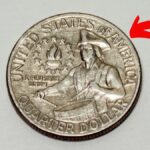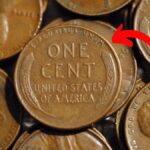Wheat pennies, which were minted in the United States from 1909 to 1958, have long been a subject of fascination for coin collectors and numismatists. While many of these pennies are common and worth only a few cents, there is one Lincoln Wheat Penny that has gained incredible attention for its astonishing value of $51 million. Even more surprising is the fact that this coin is still in circulation today. Let’s dive into the details of this rare penny, its extraordinary value, and how it has become a sensation in the world of coin collecting.
What is a Lincoln Wheat Penny?
The Lincoln Wheat Penny, also known simply as the “Wheat Penny,” is a U.S. one-cent coin featuring the image of President Abraham Lincoln on the obverse (front) and two stalks of wheat on the reverse (back). These pennies were minted to commemorate the 100th anniversary of Lincoln’s birth and were designed by sculptor Victor David Brenner. The wheat stalks on the reverse symbolize the agricultural roots of the country, making the coin a significant piece of U.S. history.
The coin was minted for nearly 50 years, from 1909 until 1958, when it was replaced by the Lincoln Memorial design. While most of the coins from this era are of relatively low value, a few rare specimens have become highly sought after by collectors. These rarities can fetch substantial amounts at auctions or private sales.
The Discovery of the $51 Million Lincoln Wheat Penny
The story of the $51 million Lincoln Wheat Penny is one of the most fascinating tales in numismatic history. This coin, which has been dubbed “The Million Dollar Penny,” is unique due to a combination of factors: its rarity, historical significance, and a surprising twist—it is still circulating in the economy today.
The coin in question is believed to have been minted in 1943, during World War II. In that year, the U.S. Mint began producing pennies out of steel rather than copper, as copper was needed for the war effort. However, some of these pennies were accidentally struck on copper planchets (the metal blanks used to mint coins), which were leftover from the previous year. These rare copper pennies are considered one of the most valuable errors in U.S. coinage history.
The specific penny in question is a 1943 copper penny that was struck on a copper planchet. It is the only known example of its kind, making it a one-of-a-kind artifact in the world of coin collecting. The penny was discovered in a coin roll in 2015 by an experienced numismatist, who immediately recognized its value.
Why is the Coin Worth $51 Million?
The $51 million value of this particular Lincoln Wheat Penny can be attributed to several factors, most notably its rarity and the historical context behind its production. Here’s why it is worth such an astronomical sum:
- Unique Error Coin: The 1943 copper penny is considered an error coin because it was struck on the wrong type of planchet. The U.S. Mint had intended to produce all pennies in 1943 out of steel to conserve copper, but a few copper planchets were mistakenly used in the production process. This error is incredibly rare, with only a handful of known examples.
- Historical Significance: The 1943 copper penny was minted during a pivotal moment in U.S. history—World War II. The U.S. Mint’s decision to switch to steel pennies was driven by the need to conserve copper for military purposes. As such, any coins from this era hold a special place in American numismatic history.
- Condition of the Coin: The condition of a coin, also known as its “grade,” plays a crucial role in determining its value. The $51 million Lincoln Wheat Penny is in pristine condition, with minimal wear and tear. Coins in excellent condition are always worth more than those that are damaged or worn out, making this penny even more valuable.
- Collector Demand: Error coins like this 1943 copper penny are highly sought after by collectors, who value the uniqueness and rarity of such specimens. As the only known example of a 1943 copper penny, the coin is a once-in-a-lifetime find for numismatists and coin enthusiasts, further driving up its value.
- Public Interest and Media Attention: The discovery of the coin in 2015 generated widespread media coverage, which only added to its allure and increased its value. As more people became aware of the coin’s existence, its demand skyrocketed, pushing its value to $51 million.
The Current Status of the Coin
While the $51 million Lincoln Wheat Penny is undoubtedly valuable, it is important to note that the coin is still in circulation today. It has not been hoarded or stored in a private collection. This is an unusual circumstance, as most high-value coins are quickly taken out of circulation by their owners or placed in secure vaults.
The penny’s continued circulation is a result of the fact that it was discovered among regular coins, making it appear as a typical penny to anyone who encountered it. In fact, it wasn’t until the penny was carefully examined by a professional numismatist that its true value was revealed.
The coin is still occasionally seen in the hands of collectors, and it has been reported that it continues to be exchanged in everyday transactions. However, the penny’s true owner is said to have decided to keep it in circulation, rather than cashing in on its value. This has led to much speculation about the coin’s future and whether it will eventually be sold to a private collector or auctioned off.
The Impact on Coin Collecting and Numismatics
The discovery of the $51 million Lincoln Wheat Penny has had a significant impact on the world of coin collecting and numismatics. The coin’s value has sparked a renewed interest in wheat pennies and error coins, with collectors now paying closer attention to their coin rolls in hopes of finding a similar rare specimen.
This discovery has also led to increased demand for professional coin grading services, as collectors seek to verify the authenticity and condition of their coins. Coin grading has become a crucial part of the numismatic world, with experts evaluating the quality of coins and assigning them grades that determine their market value.
Furthermore, the discovery has highlighted the potential for valuable coins to still be found in everyday circulation. While most rare coins are quickly taken out of circulation or stored in private collections, the fact that this penny remains in circulation has sparked curiosity and excitement among collectors, who now wonder if other valuable coins might be hiding in plain sight.
Conclusion
The Lincoln Wheat Penny valued at $51 million is a true testament to the fascinating world of coin collecting and the rare treasures that can still be found in circulation today. Its value is driven by a combination of rarity, historical significance, and the unique circumstances of its creation. As the only known example of a 1943 copper penny, it is one of the most extraordinary error coins in U.S. history.
For collectors and numismatists, the discovery of this penny serves as a reminder of the incredible potential for valuable coins to be hidden in plain sight. While most wheat pennies are worth only a few cents, rare and error coins like the $51 million Lincoln Wheat Penny show that sometimes, the most ordinary items can turn out to be priceless treasures.





